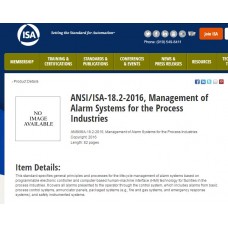ISA 18.2-2016
- Management of Alarm Systems for the Process Industries
- standard by The International Society of Automation, 03/17/2016
- Category: ISA
$303.00
$152.00
The practices in this standard are applicable to continuous, batch, and discrete processes. There can be differences in implementation to meet the specific needs based on process type.
In jurisdictions where the governing authorities (e.g., national, federal, state, province, county, city) have established process safety design, process safety management, or other requirements, in addition to the requirements of this standard, these should be taken into consideration.
The primary function within the alarm system is to notify operators of abnormal process conditions or equipment malfunctions and support the response. The alarm systems can include both the basic process control system (BPCS) and the safety instrumented system (SIS), each of which uses measurements of process conditions and logic to generate alarms. Figure 1 illustrates the concepts of alarm and response dataflow through the alarm system. The alarm system also includes a mechanism for communicating the alarm information to the operator via an HMI, usually a computer screen or an annunciator panel. Additional functions of the alarm system are an alarm and event log, an alarm historian, and the generation of performance metrics for the alarm system. There are external systems that can use the data from the alarm system.
 PDF
PDF
All of our standards document are available in PDF (Portable Document Format), an electronic, downloadable format.You will be able to download the file in your account downloads.
 Multi-User Access
Multi-User Access
After purchasing, you have the ability to assign each license to a specific user.
 Printable
Printable
At any time, you are permitted to make printed copies for your and your members' reference use.


